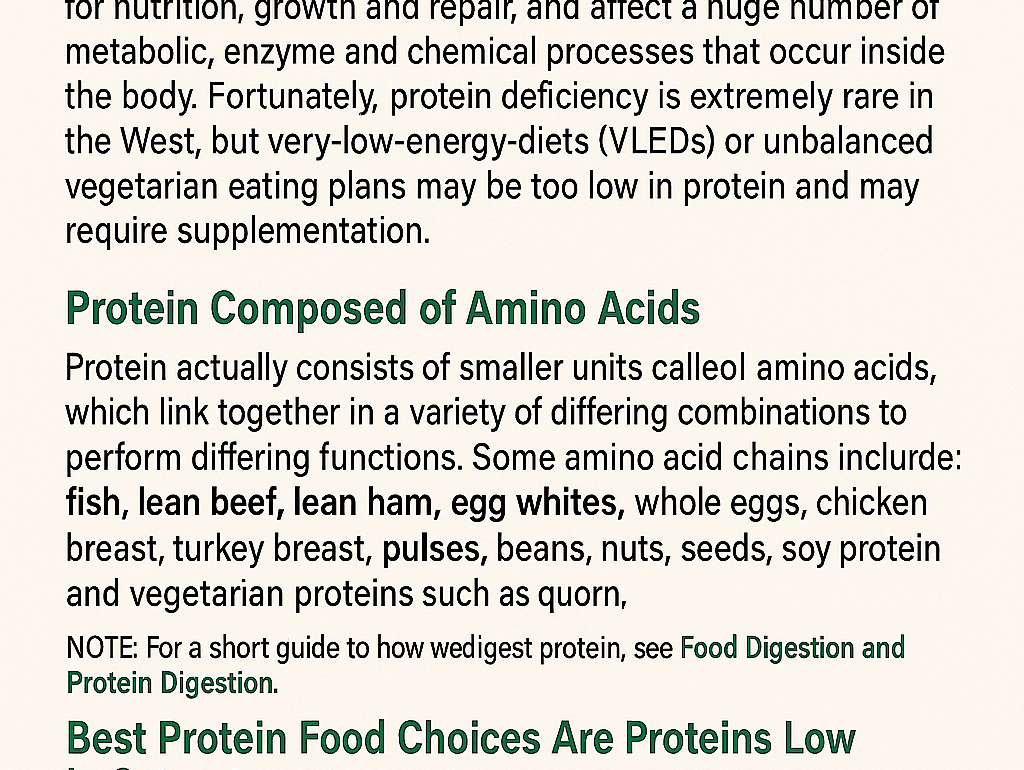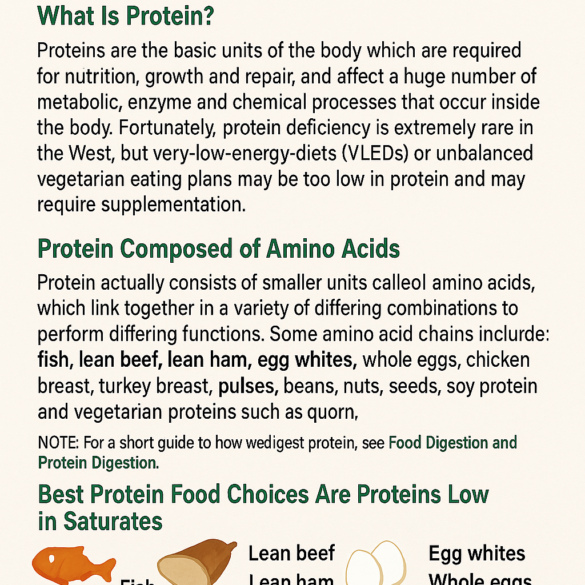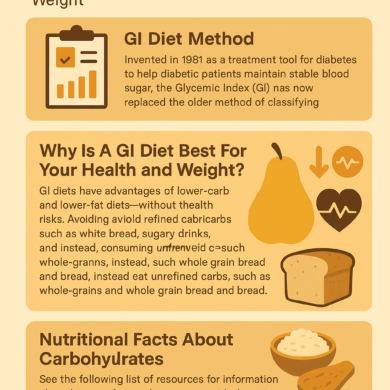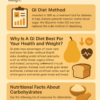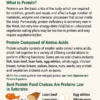Good Carbohydrates
Healthy Carbs to Eat As Part of a Healthy Diet
Good Carbs to Eat
Good Carbohydrates
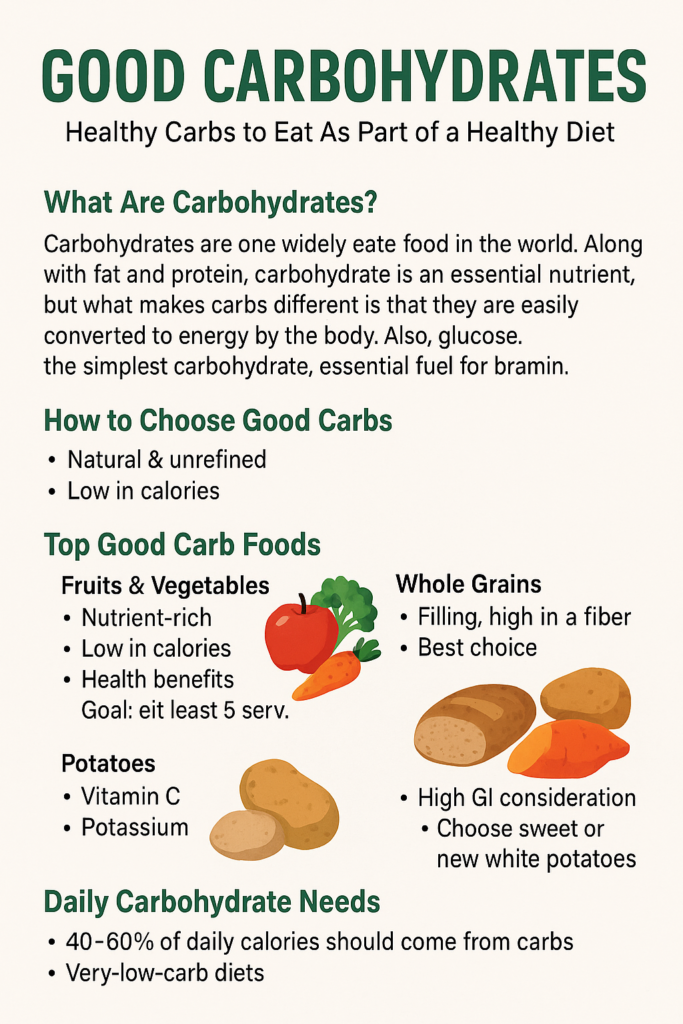
Carbohydrate (meaning “carbon plus water”) is the most widely eaten food in the world. Along with fat and protein, carbohydrate is an essential nutrient, but what makes carbs different is that they are easily converted to energy by the body. Also, glucose, the simplest carbohydrate, is essential fuel for the brain. Any healthy diet must include carbohydrates.
How to Choose Good Carbs
As a general rule, the more natural and unrefined the carb-food, the healthier it is. Also, the lower the glycemic index (GI) value, the better the carb is for your blood glucose levels. So, choose unrefined
whole grain carbs that have a low or intermediate GI rating.
Carbohydrates and Glycemic Index (GI)
The Glycemic Index (GI) is a relatively new classification of carbohydrates based on their immediate effect on our blood glucose (blood sugar) levels. Carbs that are converted to glucose very fast have a high GI value. Carbs that metabolize slowly, releasing glucose gradually into the blood stream have a low GI value. Nutritional experts now believe that high blood sugar and insulin levels, caused by overeating high-GI carbs in our present-day diet, are one of the key factors responsible for the rise in heart disease, hypertension, diabetes and insulin resistance.
Good Carb Foods
1. Fruit & Vegetables
Fruit and vegetables are generally low in calories and packed with nutrients like vitamins, minerals, phytochemicals and fiber. This means they are a healthy addition to any diet, especially if you are trying to lose weight. Studies show that people who eat plenty of fruit and vegetables have a lower risk for heart disease and some cancers. For optimum nutrition, eat at least 5 portions of fruit and vegetables every day – fresh, canned, frozen or cooked.
2. Whole Grains
This group includes pasta, rice and noodles – the starchy carbohydrates – your body’s main source of energy. All these foods begin life as a grain, such as wheat, rye, corn, rice or barley. Potatoes and grains are very healthy and filling, but for optimum health and glycemic benefits choose unrefined whole grain versions of these foods over refined versions.
Unrefined carbohydrates are medium-calorie and because they contain the whole grain, including the bran and the germ, they’re higher in fiber and keep you feeling fuller for longer – great if you’re trying to reduce weight. Examples include basmati or brown rice, Uncle Ben’s Converted long grain rice, wholegrain bread, porridge oats, and wholewheat pasta.
Curiously, the leanest and longest living people in the industrialized world are the Japanese whose diet contains regular amounts of these healthy wholegrain carbohydrates.
3. Potatoes
Another high-starch carbohydrate, potatoes have higher GI values. New white potatoes (fresh or canned) are better choices, with sweet potatoes being best of all. Potatoes are a fat-free healthy food that provide useful amounts of vitamin C, potassium and fiber. Their high GI value can be reduced by eating them with other low-GI foods as part of the same meal.
How Much Carbohydrate Do We Need in Our Daily Diet?
Assuming you choose nutritious less refined carbohydrates, you can eat anything between 40 and 60 percent of your calories in the form of carbs. If you wish to try a low-carb diet, that’s fine – but for optimum health you should avoid the very-low-carb weight loss plans except for very short periods of time. Some of these very-low-carb diets rely on nutritional supplements, which generally speaking is not a good long term dietary habit to adopt.
Good Protein
Healthy Proteins to Eat As Part of a Balanced Diet
Good Protein
What is Protein?
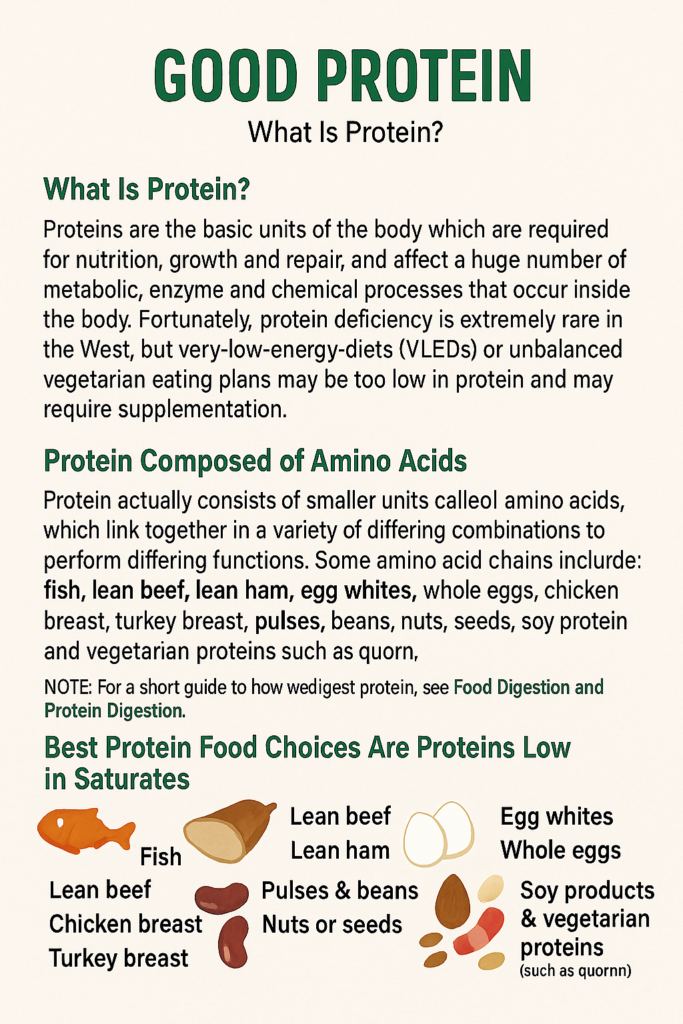
Proteins are the basic units of the body which are required for nutrition, growth and repair, and affect a huge number of metabolic, enzyme and chemical processes that occur inside the body. Fortunately, protein deficiency is extremely rare in the West, but very-low-energy-diets (VLEDs) or unbalanced vegetarian eating plans may be too low in protein and may require supplementation.
Protein Composed of Amino Acids
Protein actually consists of smaller units called amino acids, which link together in a variety of differing combinations to perform differing functions. Some amino acid chains are created by the body, but some – essential amino acids – must come from outside the body from food. Although all animal and plant cells contain some protein, the amount and the quality of the protein varies considerably.
NOTE: For a short guide to how we digest protein, see Food Digestion and Protein Digestion.
Best Protein Food Choices Are Proteins Low in Saturates
Protein may come in many forms, but the better type of protein is low in saturated fat. Good protein choices include: fish, lean beef, lean ham, egg whites, whole eggs, chicken breast, turkey breast, pulses, beans, nuts, seeds, soy products and vegetarian protein foods such as quorn and seitan.
How Much Protein Do We Need in Our Diet?
Assuming you choose nutritious protein, low in saturated fat, you can eat anything between 10 and 20 percent of your calories in the form of protein, although according to government guidelines you should not eat less than 45g of protein (adult females) or 55.5g (adult males).
In practice, eating a variety of foods every day is all you need to do in order to ensure an adequate protein intake.
Good Fats
Healthy Fats to Eat As Part of a Nutritious Diet
Good Fats to Eat

Fat has an undeserved reputation as a diet food that is bad for weight loss and health. True, saturated fat is bad for health, as it is proven to clog arteries causing heart disease and stroke. However, health warnings to “avoid saturated fat” have been misinterpreted to mean “avoid ALL fats.” But the truth is, good fat is absolutely essential for good health.
NOTE: To understand how our digestive system digests and absorbs dietary fat,
see Guide To Food Digestion and Digestion Of Fats.
What Type of Fat is “Good”?
By good fat, I mean non-saturated fat – both polyunsaturated and monounsaturated. This type of fat or oil has numerous health benefits.
- It transports fat-soluble vitamins A, D, E and K throughout the body.
- It cushions and protects internal organs.
- Essential fatty acids (EFAs), benefit your heart, metabolism and immune system.
- Some EFAs are used by the body for structural, hormonal and electrical functions rather than for energy. These EFAs increase metabolic rate and increase fat burn off resulting in loss of weight.
- Fat is a concentrated source of energy.
Saturated Fat
Saturated fats include Hydrogenated Fats or Trans-Fats – frequently found in commercial bakery products and margarines. Saturated fat is generally solid at room temperature. It is found in animal meats, chicken skin, lard, butter, hard margarine, cheese, whole milk and anything these ingredients are used in, such as cakes, chocolate, biscuits, pies and pastries.
Non-Saturated Fat
Unsaturated fat (including monounsaturates and polyunsaturates) is usually liquid at room temperature and generally comes from vegetable sources.
The Best Fats/Oils
Really good fats/oils come from UNREFINED vegetable sources or oily fish. Here are some basic guidelines for how to choose the best type of fat.
– For cooking, choose extra virgin olive oil
– For salads, choose from flax oil, canola oil, soy oil, extra virgin olive oil, wheatgerm oil, walnut oil, hemp seed oil.
– Eat regular helpings of oily fish like salmon, mackerel, sardines, tuna.
Note: Flax seed oil, hemp seed oil, canola oil and oily fish are great sources of one of the key essential fatty acids, omega-3.
What Fat/Oil is Best for Weight Loss?
If you want to lose weight, or if you’re on a reduced-fat diet, a good type of oil to use in cooking is a “Fat-Spray.” Fat-sprays typically provide 1 calorie, per spray/squirt. This compares with 120 calories per tablespoon of regular cooking oil.
Which is Best: Butter or Margarine?
Neither. Both have good and bad points. Choose whichever you prefer on bread, but use it SPARINGLY. Try to avoid adding it to other foods.
How Much Fat Do We Need in Our Daily Diet?
Official dietary health guidelines advise that fat makes up no more than 30 percent of total calories. On a 1600-calorie diet, this means about 50 grams of total fat per day. Of this, a maximum of 1/3 may be saturated fat.
For a concise explanation of how ALL surplus calories (from fats, protein AND carbs) are converted to body fat and stored as adipose tissue, see How We Gain Body Fat?
Fat Intake and Heart Health
Most heart experts and heart associations suggest a lower total daily fat intake, typically in the range 20-25 percent of calories. If you have high cholesterol, you MUST reduce your saturated fat intake to a minimum, and reduce your consumption of cholesterol-containing foods. To reduce your cholesterol, see my: Cholesterol-Lowering Diet
Advice About Sugar
Guide to Dietary Sugar in a Healthy Diet For Optimum Weight Control
Dietary Sugar
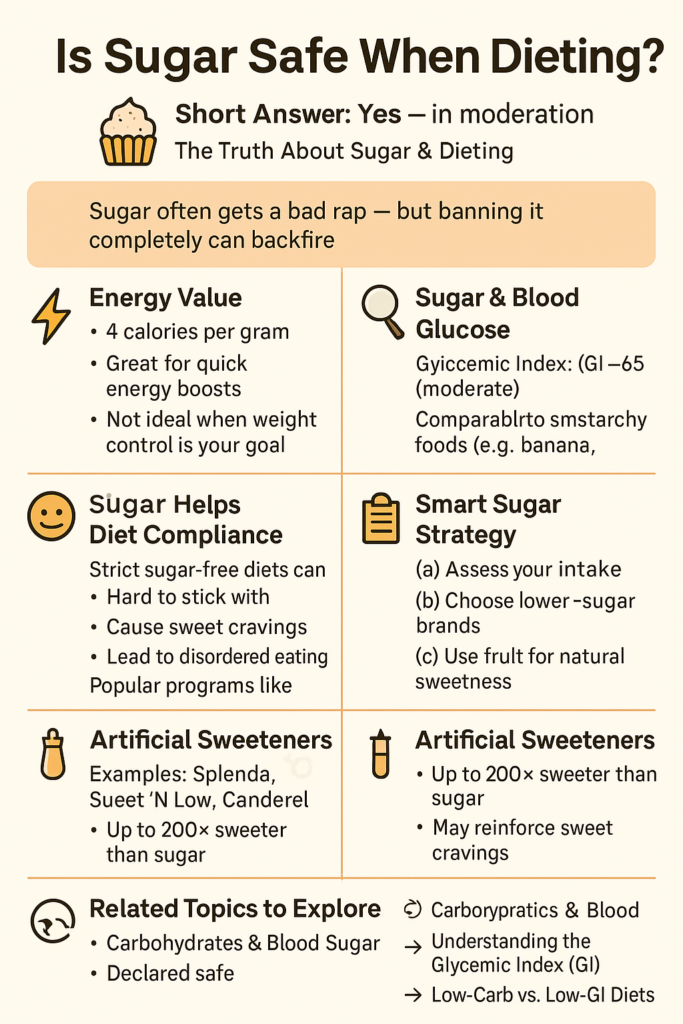
Question: Is sugar safe to eat when we’re dieting? Answer: Yes.
There’s no doubt that sugar has a bad reputation, especially for anyone trying to lose weight. But dieters often overreact and stop eating sugar altogether, which can be counter-productive. Anyway, here is my 2 cents about sugar, nutrition and weight control.
Energy Value
Sugar is a concentrated source of energy (4 calories per gram). Which means that sugary foods are great for anyone who needs a short-term energy boost, but not ideal if weight control is a priority.
Nutritional Value
Sugar contains no real nutrition. If we never had another teaspoon of dietary sugar in our life, our nutritional health would not be affected in the slightest. So from a health viewpoint sugar is valueless.
Effect of Sugar on Blood Glucose Levels
Sugar is traditionally seen as a danger to blood-glucose levels. But this reputation isn’t really deserved. Table sugar (sucrose) has a glycemic index (GI) value of 60-65 (the same as canned green pea soup!), which means it’s a moderate not a high GI food. In fact, contrary to popular opinion, most high-sugar foods do not raise blood-glucose levels any more than most complex starchy foods like bread.
Dietary Guidelines
The US Dept of Agriculture recommends that sugar makes up no more than about 8 percent of the total calories in the average diet.
Sugar Boosts Diet-Compliance
Clinical studies show that sugar-free diets are more difficult to follow in the medium-long term. In some dieters, these sugar-free eating plans can trigger cravings for sweet foods and disordered eating. Being able to enjoy occasional sugary foods is an important reward-element in most successful weight loss plans, such as Weight Watchers and Jenny Craig.
Guidelines For Weight Management
(1) We need to assess how important sugar is to us in our daily diet. If we eat a lot, then clearly we should reduce our intake to reasonable levels. We can do this by switching to foods containing natural sweetness, like fresh fruit. (No processed sugary foods can compare with a fresh pineapple or a ripe banana.) In addition, we can and should make a point of checking food labels and choosing brands with lower sugar content.
(2) The use of artificial sweeteners, like Splenda, Sweet ‘N’ Low, or Canderel, is a matter of personal taste. A question of balancing chemical factors against the reduction in calories. Also, it’s worth knowing that both nutritive and non-nutritive sweeteners can be 200 times sweeter than sugar – not ideal if you wish to reduce your “sweet tooth”.
(3) Following a sugar-free diet is not an easy option. Initial sugar withdrawal symptoms are not pleasant, and (in my experience, at least) weight loss success with such diets is infrequent.
Note About Aspartame
It’s true that aspartame is still a controversial sweetener. But unless we are experts in food biochemistry, we have no choice but to rely on those who are.
The US Food and Drug Administration (FDA) (Jan 2005) continues to state quite unambigously that aspartame is safe. The FDA states:
“Despite the overwhelming documentation of aspartame’s safety, unfounded allegations that aspartame is associated with a myriad of ailments continue to be spread via the Internet and the media by a few individuals who have no documented scientific or medical expertise.”
In addition, the FDA states:
“In an effort to alleviate myths surrounding the sweetener, Health Canada has recently re-released a statement via their Website supporting the safety and innocuousness of aspartame.”
For the full FDA text, visit: Aspartame
I guess the bottom line is this: anyone who feels strongly that aspartame is unsafe (despite what the FDA says), should avoid it. See also Fibromyalgia Diet Guide and Aspartame, MSG and Fibromyalgia.
Carbohydrates and Glycemic Index (GI)
Everything you need to know about healthy carbohydrate, how much to eat and how the Glycemic Index helps to maintain good health and weight.
GI Diet Method
How the Body Uses Its Energy Sources
Guide to Carbohydrates
How Carbs Are Digested
How Carbohydrate Affects Blood Sugar
How Carbohydrate Affects Insulin
Health Risks of Excessive Insulin
Low Carb Eating Plans
Guide to Glycemic Index (GI)
More Details About GI
How GI is Measured
What Determines GI Value of Carb-Rich Foods
Guide to Glycemic Load
GI Values of Meals
How to Reduce GI Value of Meals
Low GI Foods
How Much Carbohydrate Do We Need in Our Diet
Guide to Carbohydrate in Our Diet
Which is Best: Low Carb or Low GI Diet
Health Benefits of Low GI Diets
Guide to Dietary Fiber
Health Benefits and Food Sources of Soluble and Insoluble Fiber
Dietary Fiber: Types, Benefits and Sources
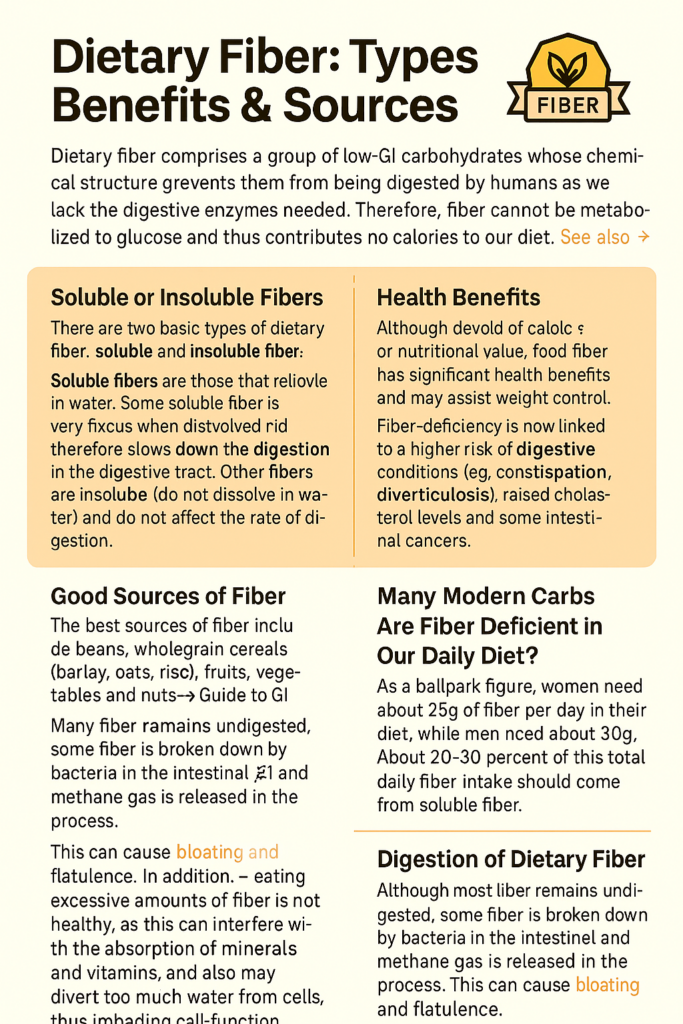
Dietary fiber comprises a group of low-GI carbohydrates whose chemical structure prevents them from being digested by humans as we lack the digestive enzymes needed. Therefore, fiber cannot be metabolized to glucose and thus contributes no calories to our diet. See also: Guide to GI
Soluble or Unsoluble Fibers
There are two basic types of dietary fiber: soluble and insoluble fiber. Soluble fibers are those that dissolve in water. Some soluble fiber is very viscous when dissolved and therefore slows down the speed of digestion in the digestive tract. Other fibers are insoluble (do not dissolve in water) and do not affect the rate of digestion. Many fiber-rich foods contain a mixture of soluble and insoluble fiber although one type usually predominates.
Health Benefits
Although devoid of caloric or nutritional value, food fiber has significant health benefits and may assist weight control. Fiber-deficiency is now linked to a higher risk of digestive conditions (eg. constipation, diverticulosis), raised cholesterol levels and some intestinal cancers. Soluble fiber slows down digestion in the stomach and intestines, thus stabilizing blood glucose levels, and may also increase the uptake of minerals and other nutrients during digestion. Insoluble fiber improves health in the intestinal tract by increasing stool volume and stimulating normal bowel contractions thus reducing passage-time through the colon. This reduces digestive complaints like constipation, irritable bowel syndrome (IBS) and diverticulitis.
Good Sources of Fiber
The best sources of fiber include beans, wholegrain cereals (barley, oats, rice), fruits, vegetables and nuts. Sources of insoluble fiber include: wheat, corn, rice, veggies and beans. Sources of soluble fiber include: citrus fruits, apples, mango, oats, dried apricots and beans (haricot, soybeans).
Many Modern Carbs are Fiber Deficient
Modern food refining techniques have gradually removed more and more of the natural fiber and other non-digestible parts of carb foods like wheat, rice and oats. For example, flour is typically stripped of it’s fiber-containing shell or chafe, bleached and super-refined, in order to make lighter breads with a longer shelf-life. These refined carb foods are less natural, less filling, and have a higher glycemic index than traditional chewier breads.
How Much Fiber Do We Need in Our Daily Diet?
As a ballpark figure, women need about 25g of fiber per day in their diet, while men need about 30g. About 20-30 percent of this total daily fiber intake should come from soluble fiber.
Digestion of Dietary Fiber
Although most fiber remains undigested, some fiber is broken down by bacteria in the intestinal and methane gas is released in the process. This can cause bloating and flatulence. In addition, eating excessive amounts of fiber is not healthy as this can interfere with the absorption of minerals and vitamins, and also may divert too much water from the cells, thus impeding cell-function. Therefore, unless otherwise advised by your doctor, increase your fiber intake gradually and avoid fiber supplements.
Dietary Fiber Helps Weight Loss
How Soluble and Insoluble Fiber in Diet Improves Weight Reduction
Fiber Benefits Weight
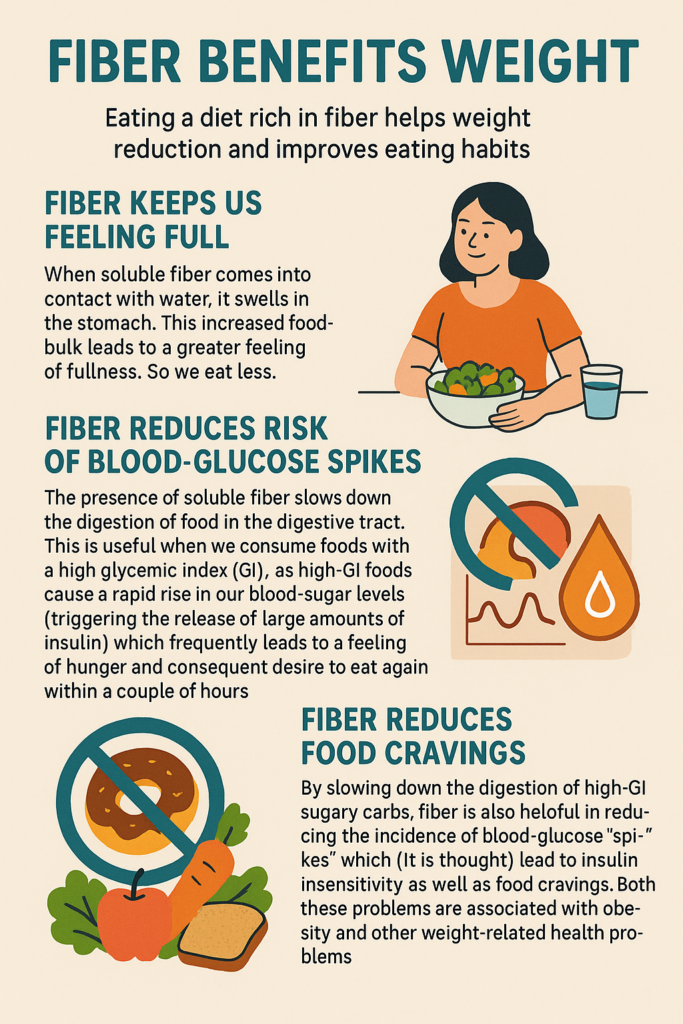
Eating a diet rich in fiber helps weight reduction and improves eating habits.
Fiber Keeps Us Feeling Full
When soluble fiber comes into contact with water, it swells in the stomach. This increased food-bulk leads to a greater feeling of fullness. So we eat less.
Fiber Reduces Risk of Blood-Glucose Spikes
The presence of soluble fiber slows down the digestion of food in the digestive tract. This is useful when we consume foods with a high glycemic index (GI), as high-GI foods cause a rapid rise in our blood-sugar levels (triggering the release of large amounts of insulin) which frequently leads to a feeling of hunger and consequent desire to eat again within a couple of hours.
Fiber Reduces Food Cravings
By slowing down the digestion of high-GI sugary carbs, fiber is also helpful in reducing the incidence of blood-glucose “spikes” which (it is thought) lead to insulin insensitivity as well as food cravings. Both these problems are associated with obesity and other weight-related health problems.
Fiber Helps Us to Eat Healthy Foods
A fiber-rich diet is likely to be richer in nutrients than a low-fiber diet. This because fiber is found mainly in vegetables, fruits, whole grains, nuts and seeds – all very healthy foods and great for weight loss. By increasing our daily fiber intake, we are likely to improve our eating habits and our chances of losing weight.
A Healthy Diet Makes it Easier to Lose Weight
It’s worth remembering that 20 minerals and 13 vitamins are essential for health. Their presence or absence can change the rate at which energy is produced or calories burned. In a nutshell, a healthy diet helps us to lose weight faster.
Best Vitamins for Weight Reduction
Vitamin Nutrients to Benefit Appetite, Hunger, Metabolism and Calorie Burning
Best Vitamins for Weight
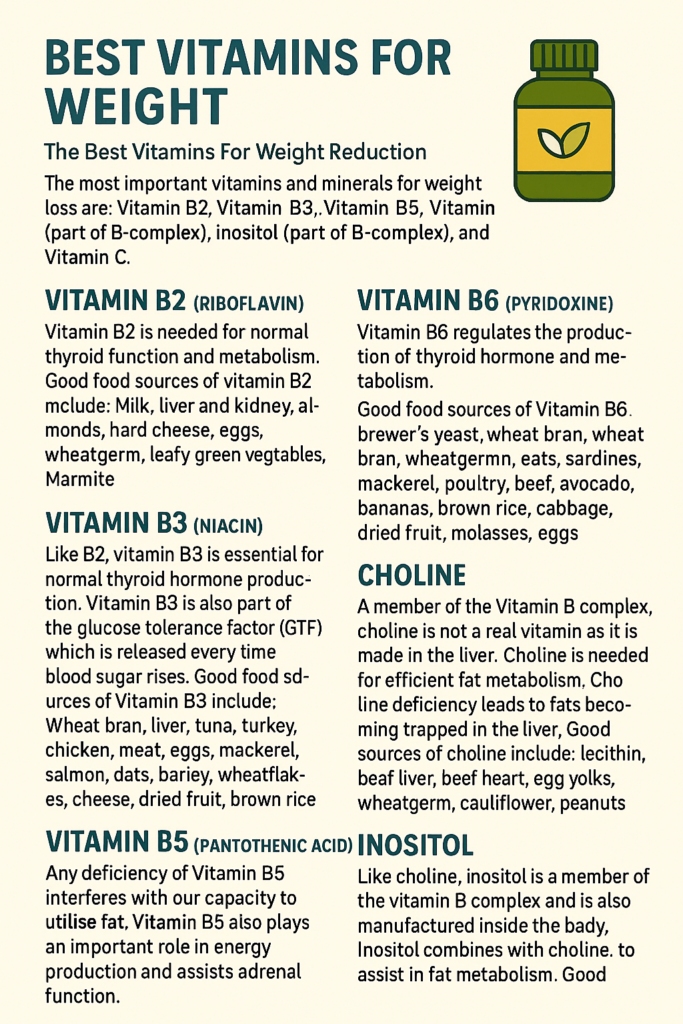
The body’s weight-control or weight-related functions – like appetite, hunger, metabolic rate, metabolism of fats and sugars, calorie-burning, and so on – operate more efficiently with an optimum intake of vitamins. All of them play a part in maintaining optimum health and weight, and many operate together, so it’s not really accurate to single out certain vitamins as being “best” for weight loss. That said, certain vitamins are worth a special mention.
The Best Vitamins For Weight Reduction
The most important vitamins and minerals for weight loss are: Vitamin B2, Vitamin B3, Vitamin B5, Vitamin B6, Choline (part of B-complex), Inositol (part of B-complex), and Vitamin C.
Vitamin B2 (Riboflavin)
Vitamin B2 is needed for normal thyroid function and metabolism. Good food sources of vitamin B2 include: Milk, liver and kidney, almonds, hard cheese, eggs, wheatgerm, leafy green vegetables, Marmite.
Vitamin B3 (Niacin)
Like B2, vitamin B3 is essential for normal thyroid hormone production. Vitamin B3 is also part of the glucose tolerance factor (GTF) which is released every time blood sugar rises. Good food sources of Vitamin B3 include: Wheat bran, liver, tuna, turkey, chicken, meat, eggs, mackerel, salmon, oats, barley, wheatflakes, cheese, dried fruit, brown rice.
Vitamin B5 (Pantothenic Acid)
Any deficiency of Vitamin B5 interferes with our capacity to utilise fat. Vitamin B5 also plays an important role in energy production and assists adrenal function. Good food sources of Vitamin B5 include: liver and kidney, meat, poultry, nuts, wheatflakes, wheat bran, wheatgerm, eggs, molasses, oats, barley, beans, wholegrain bread, green vegetables.
Vitamin B6 (Pyridoxine)
Vitamin B6 regulates the production of thyroid hormone and metabolism. Good food sources of Vitamin B6, brewer’s yeast, wheat bran, wheatgerm, oats, sardines, mackerel, poultry, beef, avocado, bananas, brown rice, cabbage, dried fruit, molasses, eggs.
Choline
A member of the Vitamin B complex, choline is not a real vitamin as it is made in the liver. Choline is needed for efficient fat metabolism. Choline deficiency leads to fats becoming trapped in the liver. Good sources of choline include: lecithin, beef liver, beef heart, egg yolks, wheatgerm, cauliflower, cucumber, peanuts.
Inositol
Like choline, inositol is a member of the vitamin B complex and is also manufactured inside the body. Inositol combines with choline to assist in fat metabolism. Good sources of inositol include: lecithin, beef heart, beef liver, wheatgerm, soy, eggs, citrus fruits, wholegrains, nuts.
Vitamin C
Vitamin C provides a range of health benefits including proper conversion of glucose to energy in the cells. Good food sources of vitamin C include: blackcurrants, broccoli, green peppers, kiwi fruits, Brussels Sprouts, lemons, oranges, strawberries, cabbage.
Best Minerals For Weight Control
Mineral Nutrition to Benefit Appetite, Hunger, Metabolism and Calorie Burning
Best Minerals For Weight
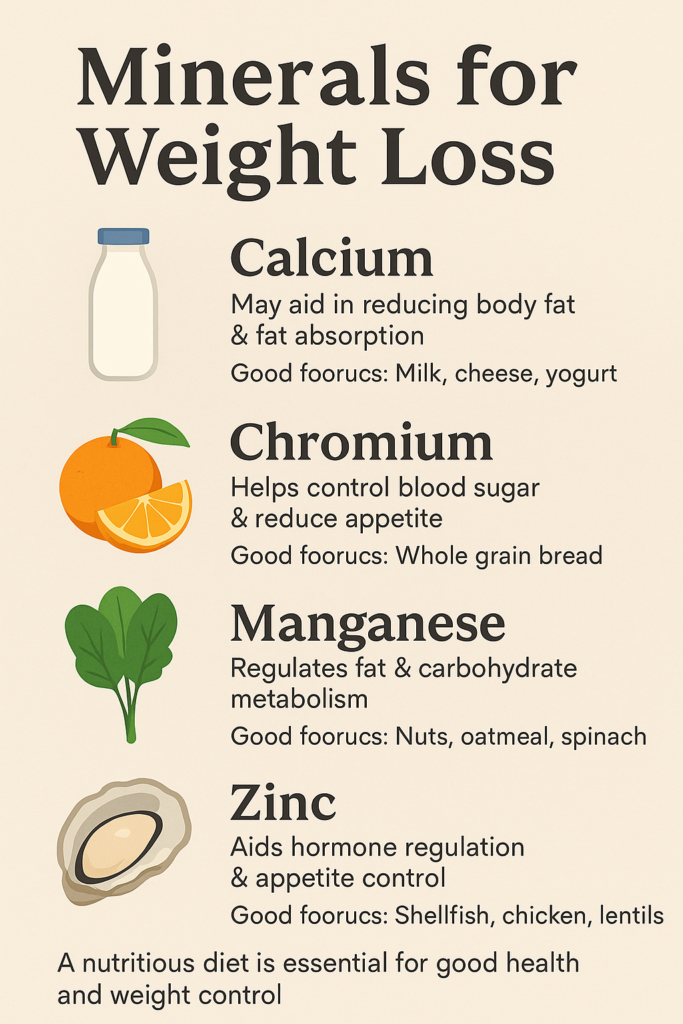
Which Minerals are Best for Weight Loss
The body’s weight-related functions – like appetite, hunger, metabolic rate, metabolism of fats and sugars, blood-glucose levels, calorie-burning, and so on – operate more efficiently when we have an optimum intake of minerals. All of them play a part in maintaining optimum health and weight, and many co-operate with each other, so it’s not strictly accurate to single out certain minerals as being “best” for weight loss. That said, certain minerals are worth a special mention.
Calcium
Recent clinical studies demonstrate a positive relationship between calcium intake and weight-loss. Controlled weight loss studies indicate that increasing calcium intake by the equivalent of two dairy servings per day can reduce the risk of overweight, perhaps by as much as 70 percent.Also, it’s worth remembering that lower-calorie fat-free milk contains the same amount of calcium as full-fat milk. The same goes for low fat yogurt and reduced fat cheese.
Chromium
Chromium is required for the metabolism of sugar. Without sufficient chromium, insulin is less effective in regulating blood-glucose levels. In this way, chromium helps to control cravings and reduce hunger. Good food sources of chromium include: egg yolks, molasses, beef, hard cheese, liver, fruit juices, whole grain bread.
Manganese
Manganese helps regulate fat metabolism and blood-glucose. It is needed for a healthy thyroid function which itself is essential to maintain a healthy weight. Good food sources of manganese include: tea, wheatgerm, spinach, split peas, nuts, oatgerm, oatmeal, pineapple, green leafy vegetables.
Zinc
Zinc helps to regulate appetite. Zinc is also needed for the correct functioning of hormones, like insulin. Zinc deficiency is common among smokers, heavy drinkers, some vegetarians, people with chronic illness and those on non-nutritious or very low calorie diets. Good sources of Zinc include: shellfish, herring, wheatgerm, lean beef or lamb, eggs, lentils, Brazil nuts, almonds, chicken
Diet Nutrition Information and Guidelines
Nutrition Is Vital For Health and Weight Control
A nutritious diet is essential for good health and weight control. In particular, a nutritional eating plan will definitely improve your chances of fast weight loss. So avoid fad diets or any type of eating plan that restricts you to certain foods. Instead, choose a healthy calorie-controlled diet rich in fruit and vegetables, moderate in protein and low in saturated fat or trans fatty acids, with foods from all main food groups. This helps to improve metabolism, maintain a stable appetite and eliminate cravings. Which makes weight reduction easier and faster, and future weight gain less likely.
For more information about the best foods – including the best carbs, fats and protein – sodium, cholesterol and vegetarian nutrition, plus information on the nutritional benefits of specific foods, including the effects of phyto-chemicals, carotenoids, antioxidant vitamins and minerals, essential fatty acids and omega-3/6 fats, plus advice on diet nutrition for special health conditions, please see below.
Digestive System And Dietary Nutrition
Our food digestion system (mouth, esophagus, stomach, small intestine, large intestine) helps us to obtain energy and nutrients from food. If our digestive tract cannot properly absorb macronutrients and micronutrients we become vulnerable to nutritional deficiencies. Carbohydrate, fats and protein are each digested differently within the gastrointestinal tract, but surplus calories from these three macronutrients are ALL converted to body fat.
Diet Foods
Information About Foods for Healthy Weight Loss and Diet Nutrition
Foods To Include in Your Healthy Weight Loss Diet
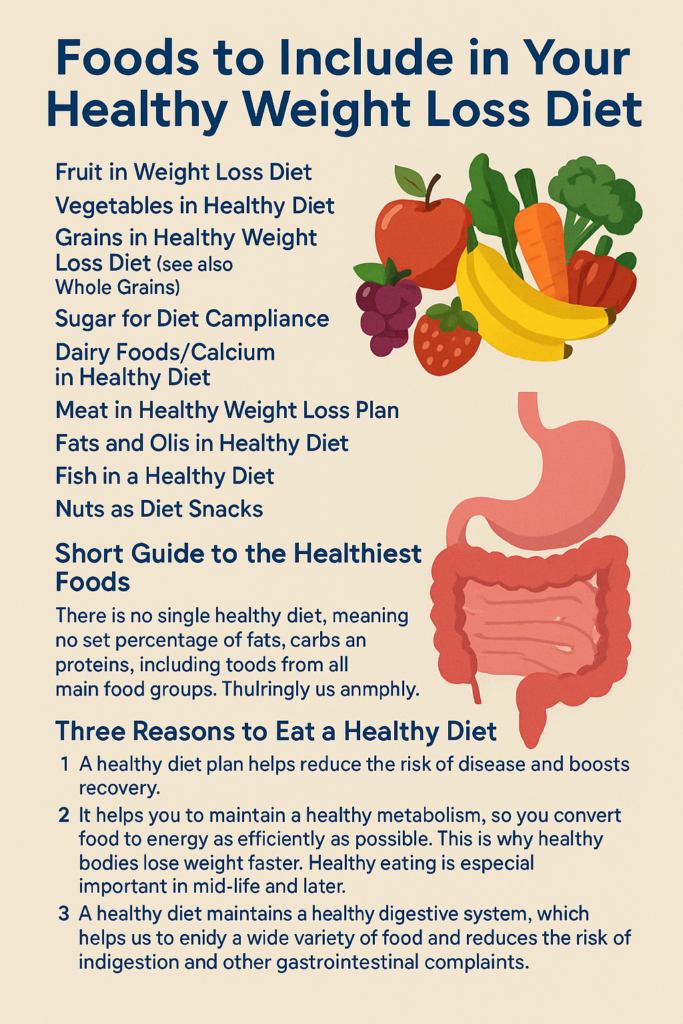
For details of the nutritional and weight loss benefits of the main food groups, see following list of foods:
Fruit in Weight Loss Diet
Vegetables in Healthy Diet
Grains in Healthy Weight Loss Diet (see also Whole Grains)
Sugar For Diet Compliance
Dairy Foods/Calcium in Healthy Diet
Meat in Healthy Weight Loss Plan
Fats and Oils in Healthy Diet
Fish in a Healthy Diet
Nuts As Diet Snacks
Short Guide To The Healthiest Foods
There is no single healthy diet, meaning no set percentage of fats, carbs and proteins. That said, the healthiest diet includes foods from all the main food groups. In general, the healthiest fats are unrefined vegetable oils; the healthiest protein includes fish, lean beef and chicken, beans and soy foods; the healthiest carbohydrate includes vegetables, fruits, whole grains and beans. Dietary fiber is important too, both soluble and insoluble. Beans, apples, oats, fresh fruits and vegetables, nuts and seeds provide useful amounts of fiber.
Three Reasons To Eat A Healthy Diet
First and most important, a healthy diet plan helps reduce the risk of disease and boosts recovery. Second, it helps you to maintain a healthy metabolism, so you convert food to energy as efficiently as possible. This is why healthy bodies lose weight faster. Healthy eating is especially important in mid-life and later. Thirdly, a healthy diet maintains a healthy digestive system, which helps us to enjoy a wide variety of food and reduces the risk of indigestion and other gastrointestinal complaints.
The Digestive System
Our food digestion system (mouth, esophagus, stomach, small intestine, large intestine) helps us to obtain energy and nutrients from food. Carbohydrate, fats and protein are each digested differently within the gastrointestinal tract, but surplus calories from these three macronutrients are ALL converted to body fat.
Sodium in Foods
Salt or Sodium Content, Composition of Food
Sodium in Foods
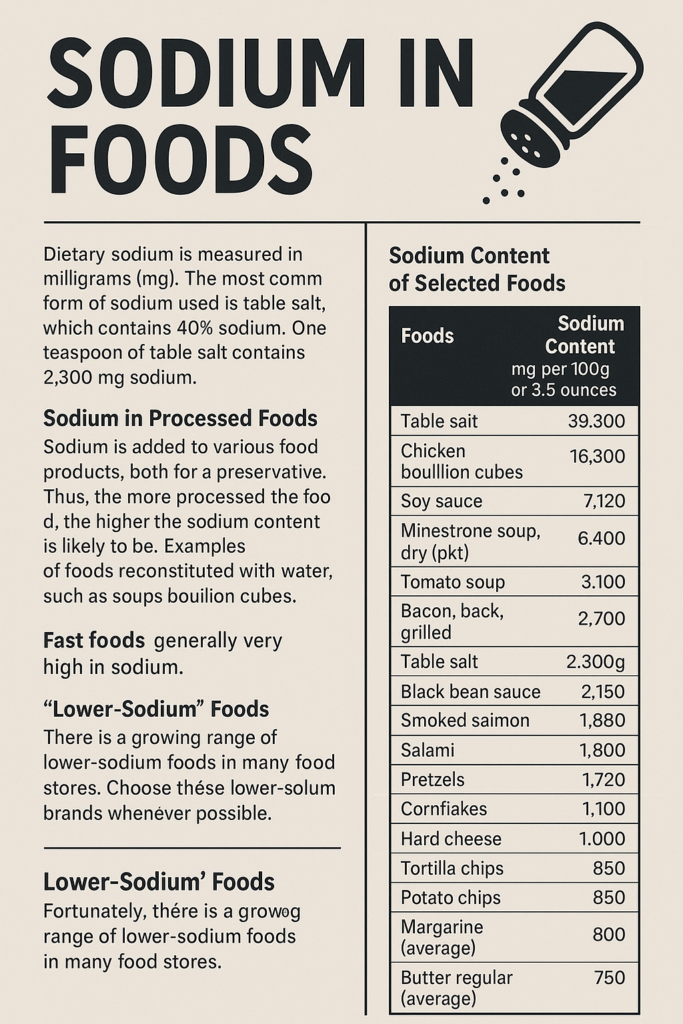
Dietary sodium is measured in milligrams (mg). The most common form of sodium used is table salt, which is 40% sodium. One teaspoon of table salt contains 2,300 milligrams of sodium.
Sodium in Processed Foods
Sodium is also added to various food products, both for taste and as a preservative. Thus, the more processed the food, the higher the sodium content is likely to be. Foods reconstituted with water (eg. soups, bouillon cubes, processed meats) also contain salt. Some of these added forms are monosodium glutamate, sodium nitrite, sodium saccharin, baking soda (sodium bicarbonate), and sodium benzoate.
Sodium in Fast Foods
Fast foods are generally very high in sodium. Another reason to eat in.
“Lower-Sodium” Foods
Fortunately, there is a growing range of lower-sodium foods in many food stores. Ideally, choose these lower-sodium brands whenever possible.
Table 1. Sodium Content of Selected Foods
| Foods | Sodium Content mg per 100g or 3.5 ounces |
| Table salt | 39,300 mg |
| Chicken bouillon cubes | 16,300 mg |
| Soy sauce | 7,120 mg |
| Minestrone soup, dry (pkt) | 6,400 mg |
| Tomato soup, dry (pkt) | 3,100 mg |
| Bacon, back, grilled | 2,700 mg |
| Table salt | 2,300 mg per teaspoon |
| Black bean sauce | 2,150 mg |
| Smoked salmon | 1,880 mg |
| Salami | 1,800 mg |
| Pretzels | 1,720 mg |
| Cornflakes | 1,100 mg |
| Hard cheese | 1,000 mg |
| Tortilla chips | 850 mg |
| Potato chips | 850 mg |
| Margarine (average) | 800 mg |
| Butter regular, (average) | 750 mg |
Healthy Weight Loss Program
For the BEST VALUE weight loss diet on the Internet, PACKED with “brilliant” weight loss tips,
Protein in Foods
Animal & Plant Food Sources of Protein, Including Vegetarian
Protein in Foods
Protein Foods – Animal Foods vs. Plant Foods
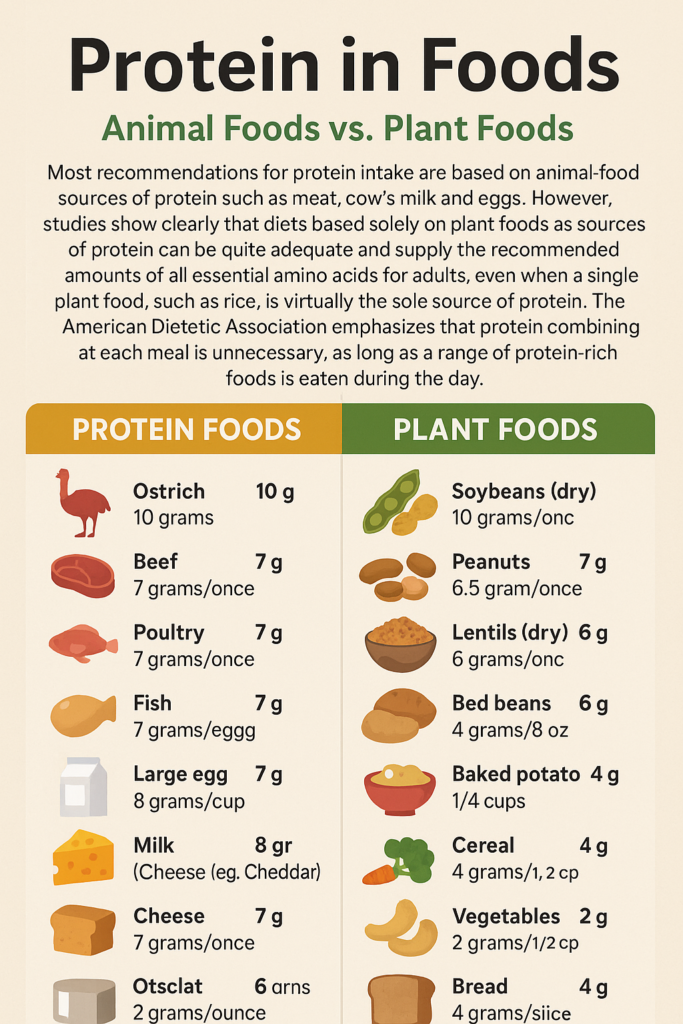
Most recommendations for protein intake are based on animal-food sources of protein such as meat, cow’s milk and eggs. However, studies show clearly that diets based solely on plant foods as sources of protein can be quite adequate and supply the recommended amounts of all essential amino acids for adults, even when a single plant food, such as rice, is virtually the sole source of protein. The American Dietetic Association emphasizes that protein combining at each meal is unnecessary, as long as a range of protein rich foods is eaten during the day.
Table 1. Approximate Protein in Selected Foods
| ds | Protein Content |
| Ostrich | 10 grams/ounce |
| Beef | 7 grams/ounce |
| Poultry | 7 grams/ounce |
| Fish | 7 grams/ounce |
| Large Egg | 7 grams/egg |
| Milk | 8 grams/cup |
| Cheese (eg. Cheddar) | 7 grams/ounce |
| Bread | 4 grams/slice |
| Cereal | 4 grams/1/2 cup |
| Vegetables | 2 grams/ 1/2 cup |
| Soybeans (dry) | 10 grams/ounce |
| Peanuts | 7 grams/ounce |
| Lentils (dry) | 6.5 grams/ounce |
| Red beans | 6 grams/ounce |
| Baked potato | 9 grams/8 ounces |
| Cashews | 5 grams/ounce |
Cholesterol in Foods
Information About Dietary Cholesterol Content of Food Groups
Cholesterol in Foods
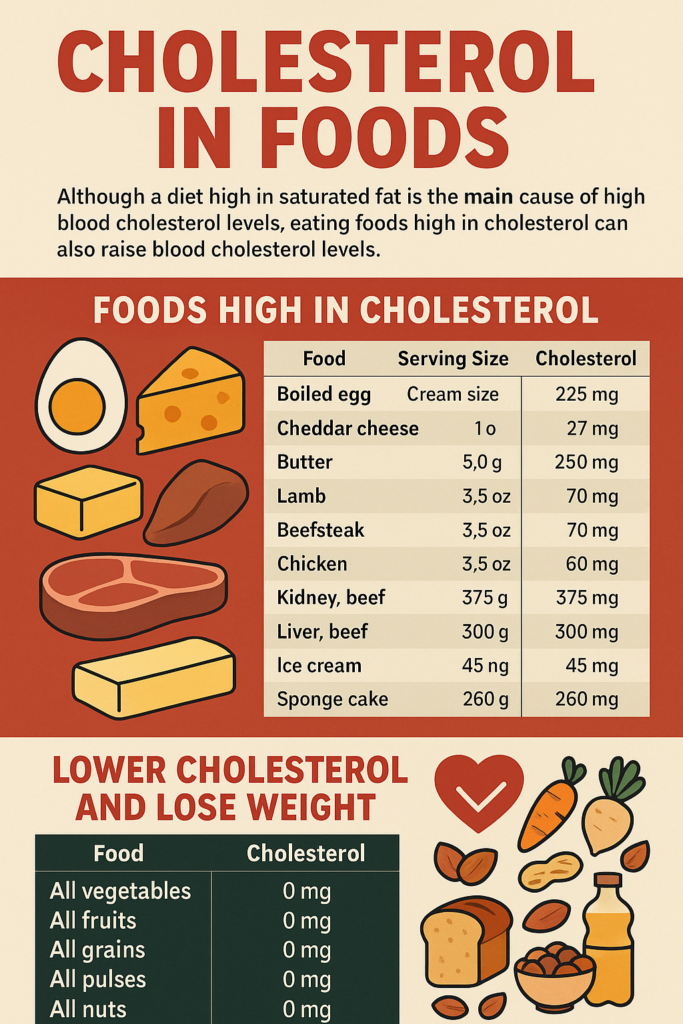
Although a diet high in saturated fat is the main cause of high blood cholesterol levels, eating foods high in cholesterol can also raise blood cholesterol levels. And usually the effect is twice as bad, because foods high in cholesterol are usually ALSO high in saturated fat.
Table 1. Foods High in Cholesterol
| Food | Serving Size | Cholesterol |
| Boiled egg | 1 | 225 mg |
| Cream cheese | 1oz | 27 mg |
| Cheddar cheese | 1oz | 19 mg |
| Butter | 3.5oz | 250 mg |
| Lamb | 3.5oz | 70 mg |
| Beefsteak | 3.5oz | 70 mg |
| Chicken | 3.5oz | 60 mg |
| Kidney, beef | 3.5oz | 375 mg |
| Liver, beef | 3.5oz | 300 mg |
| Ice Cream | 3.5oz | 45 mg |
| Sponge cake | 3.5oz | 260 mg |
Lower Cholesterol and Lose Weight
For the BEST VALUE low cholesterol weight loss diet on the Internet, PACKED with “brilliant” weight loss tips,
| Food | Cholesterol |
| All vegetables | 0 mg |
| All fruits | 0 mg |
| All grains | 0 mg |
| All pulses | 0 mg |
| All nuts | 0 mg |
| All seeds | 0 mg |
| All vegetable oils | 0 mg |
Source: Amended from Pennington, J. Food Values of Portions Commonly Used, Harper and Row, 14th ed. New York, 1985.
Anne Collins Easy Vegetarian Diet
| Anne Collins Vegetarian Diet is probably the easiest vegetarian diet program you’ll ever see. Designed mainly for ovo-lacto vegetarians, it’s adaptable for ALL vegetarians including vegans. You should lose 10 pounds a month – more if you are very overweight. The ultimate SUPER-SIMPLE veggie diet. |
Vegetarian “Quick-Start” Diet: Summary
- 28-day super-simple vegetarian weight loss plan
- Wide variety of delicious but quick-and-easy meals
- Calorie values given for EVERY FOOD ITEM
- Full list of food substitutions for picky eaters
- Full snack list
- Vegetarian fast food
- Full shopping list
Contents
This is a balanced lacto-ovo vegetarian diet – for vegetarians who eat milk and eggs. It provides about 1250 calories a day. Depending on your gender and how much weight you have to lose, you may increase this to 2000+ calories, by choosing from a wide range of calorie-controlled snacks. The Anne Collins Vegetarian Quick-Start Diet offers a range of advice on diet nutrition and weight issues. Recipes are designed to be as SIMPLE as possible.
It contains more than 90 easy recipes to choose from, including a wide range of quick recipes for soups and dips, plus simple advice on cooking grains and the best fast-food options. No more boredom with cottage cheese at every meal! A shopping list is included for each week.
For your convenience and information, each food item is listed with its calorie-content.
This is an Ideal Weight Loss Plan For…
The Vegetarian Quick-Start Diet is perfect for anyone who enjoys vegetarian food, or wants to eat less meat, and who wants to lose body fat as fast as possible.
Achieving Your Weight Loss Goals
The Vegetarian Quick-Start Diet runs for four weeks. After this, you may continue your weight loss by repeating the diet plan, or switch to our
